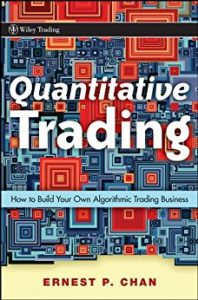This book contains basic concepts and approach (step by step) for does that want to initiate themselves on Quantitative trading. The focus is on statistical arbitrage trading, that deals with the simplest financial instruments: stocks, futures, and sometimes currencies.
The chapters cover the steps a trader should take:
- The Whats, Whos, and Whys of Quantitative Trading,
- Fishing for Ideas,
- Backtesting,
- Setting Up Your Business,
- Execution Systems,
- Money and Risk Management,
- Special Topics in Quantitative Trading, (reading it now)
- Conclusions.
You can follow the author blog that contains further valuable information and some nice examples.
 A short list of common pitfalls related to how the back-test program is written:
A short list of common pitfalls related to how the back-test program is written:
- Survivor-ship bias: data does not contain companies that have fallen bankruptcy.
- Look-Ahead Bias: this phenomenon happens when you are using information that was available only at a time ahead of the instant the trade was made. For instance, “Buy when the stock is within 1 percent of the day’s low”.
- Data-Snooping Bias: the use too much parameters that make you build an over-optimized model. A rule of thumb: 5 parameters.
- Sample size: you need enough data to back test, how much? As a rule of thumb, let’s assume that the number of data points needed for optimizing your parameters is equal to 252 times the number of free parameters your model has. For instance, you define a daily trading model with three parameters, then you should have at least three years’ worth of back-test data with daily prices.
- Out-of-Sample Testing: divide your historical data into 2 parts. Use the first part for training, and keep the second part to test the resulting model.